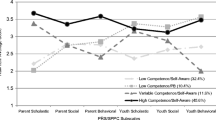Abstract
The Perceived Competence and Acceptance Scale for Younger Children (PCS) was examined in the course of an epidemiological survey of psychological disorders in children. Eighty-three children, aged 6 and 7 years, were administered several measures including the WISC-R, the WRAT, the Lie Scale for Children, and the PCS. Teachers provided ratings from a parallel version of the PCS and reported on the behavioral and social development of each child through the Child Behavior Checklist. Investigation of the psychometric characteristics of the PCS substantially replicates findings reported by its developers. The size and direction of correlations among the cognitive competence subscale of the PCS, achievement measures, and the Lie Scale indicate that children tend to more accurately report about this domain than others included in the PCS. Children who reported atypically high or low PCS levels were not found to differ from the remainder of the sample on two clinical indices. Children who tended to exaggerate PCS levels, as compared to teacher ratings, had significantly more behavior problems in school and were seen by two observers as more apt to be currently maladjusted.
Similar content being viewed by others
References
Achenbach, T. The child behavior profile: I. Boys aged 6–11 years.Journal of Consulting and Clinical Psychology, 1978,46, 478–488.
Coopersmith, S.The antecedents of self-esteem. San Francisco: Freeman, 1967.
Cronbach, L. J. Coefficient alpha and the internal structure of tests.Psychometrika, 1951,16, 297–334.
Earls, F. Prevalence of behavior problems in 3-year-old children: A cross-national replication.Archives of General Psychiatry, 1980,37, 1153–1157.
Garrison, W., & Earls, F. Attachment to a special object at the age of three years: Behavior and temperament characteristics.Child Psychiatry and Human Development, 1982,12, 131–141.
Harter, S. Effectance motivation reconsidered: Toward a developmental model.Human Development, 1978,1, 34–64.
Harter, S. The perceived competence scale for children.Child Development, 1982,53, 87–97.
Piers, E.Manual for the Piers-Harris Children's Self Concept Scale. Nashville, Tennessee: Counselor Recordings and Tests, 1969.
Sarason, S. B., Lighthall, F., Davidson, K., Waite, R., & Ruebush, B.Anxiety in elementary school children. New York: Wiley, 1960.
Wylie, R.The self-concept (Vol. 1):A review of methodological considerations and measuring instruments. Lincoln: University of Nebraska Press, 1974.
Author information
Authors and Affiliations
Additional information
This research was supported by grant number MH-37044 from the National Institute of Mental Health, U. S. Public Health Service.
Rights and permissions
About this article
Cite this article
Garrison, W., Earls, F. & Kindlon, D. An application of the pictorial scale of perceived competence and acceptance within an epidemiological survey. J Abnorm Child Psychol 11, 367–377 (1983). https://doi.org/10.1007/BF00914245
Revised:
Issue Date:
DOI: https://doi.org/10.1007/BF00914245




